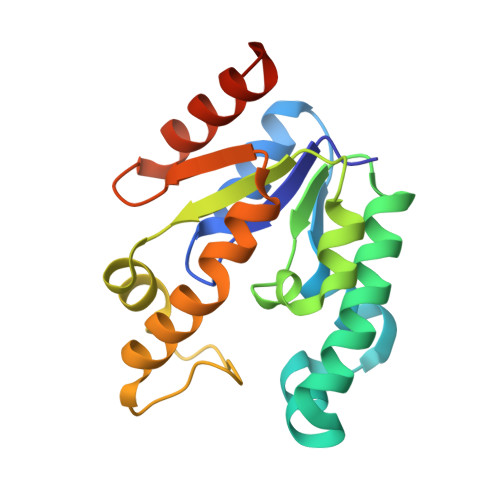Mycobacterium tuberculosis shikimate kinase inhibitors: design and simulation studies of the catalytic turnover.
Blanco, B., Prado, V., Lence, E., Otero, J.M., Garcia-Doval, C., van Raaij, M.J., Llamas-Saiz, A.L., Lamb, H., Hawkins, A.R., Gonzalez-Bello, C.(2013) J Am Chem Soc 135: 12366-12376
- PubMed: 23889343
- DOI: https://doi.org/10.1021/ja405853p
- PubMed Abstract:
Shikimate kinase (SK) is an essential enzyme in several pathogenic bacteria and does not have any counterpart in human cells, thus making it an attractive target for the development of new antibiotics. The key interactions of the substrate and product binding and the enzyme movements that are essential for catalytic turnover of the Mycobacterium tuberculosis shikimate kinase enzyme (Mt-SK) have been investigated by structural and computational studies. Based on these studies several substrate analogs were designed and assayed. The crystal structure of Mt-SK in complex with ADP and one of the most potent inhibitors has been solved at 2.15 Å. These studies reveal that the fixation of the diaxial conformation of the C4 and C5 hydroxyl groups recognized by the enzyme or the replacement of the C3 hydroxyl group in the natural substrate by an amino group is a promising strategy for inhibition because it causes a dramatic reduction of the flexibility of the LID and shikimic acid binding domains. Molecular dynamics simulation studies showed that the product is expelled from the active site by three arginines (Arg117, Arg136, and Arg58). This finding represents a previously unknown key role of these conserved residues. These studies highlight the key role of the shikimic acid binding domain in the catalysis and provide guidance for future inhibitor designs.
Organizational Affiliation:
Centro Singular de Investigación en Química Biológica y Materiales Moleculares, Universidad de Santiago de Compostela, 15782 Santiago de Compostela, Spain.
















